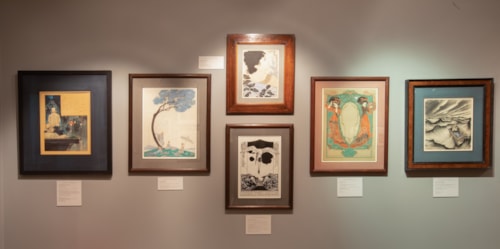Auguste ROUBILLE
(Paris 1872 - Paris 1955)
Le Cri de Paris
Pencil, black ink and gouache.
Signed ARoubille at the lower right.
237 x 173 mm. (9 3/8 x 6 3/4 in.) [image]
278 x 213 mm. (10 7/8 x 8 3/8 in.) [sheet]
Signed ARoubille at the lower right.
237 x 173 mm. (9 3/8 x 6 3/4 in.) [image]
278 x 213 mm. (10 7/8 x 8 3/8 in.) [sheet]
An illustrated political magazine which took its name from the vendors who had proclaimed their offers and services in the streets of Paris since the thirteenth century, Le Cri de Paris was launched in 1897 by Alexandre Natanson. Since 1889, Natanson and his brothers Alfred and Thadée had published La Revue Blanche, an influential art and literary magazine, and Le Cri de Paris was initially issued as a supplement to the older publication. Natanson began the weekly Le Cri de Paris in an effort to target a more politically progessive audience, with each issue advertised in La Revue Blanche and selling at a price of thirty centimes.
This drawing by Auguste Roubille is a design for one such full-page advertisement for the magazine, which appeared in the issue of La Revue Blanche of 15th April 1898. Le Cri de Paris continued to appear long after the demise of La Revue Blanche in 1903. After more than two thousand issues, it ceased publication shortly before the German occupation of Paris in June 1940.
This drawing by Auguste Roubille is a design for one such full-page advertisement for the magazine, which appeared in the issue of La Revue Blanche of 15th April 1898. Le Cri de Paris continued to appear long after the demise of La Revue Blanche in 1903. After more than two thousand issues, it ceased publication shortly before the German occupation of Paris in June 1940.
A painter, draughtsman, poster designer, caricaturist and illustrator, Auguste Jean Baptiste Roubille exhibited his watercolours and gouaches at the Salon des Indépendants and the Salon d’Automne, as well as the Salon des Humoristes, for which he also designed several posters. Roubille was an extremely versatile artist, at times working in an imposing Nabis manner and at others in a more traditional illustrative style. As an illustrator, his métier lay in satire, both of a political and comedic nature. His first illustrations appeared in Les Temps nouveaux in 1896 and the Courrier français in 1897, and his drawings, illustrations and cartoons later appeared in such publications as Le Rire, Cocorico, Le Canard Sauvage, Le Sourire and Le Cri de Paris, while from 1906 until 1933 he provided cover illustrations for the satirical magazine Fantasio.
Although best known for his cartoons and drawings of comical subjects, Roubille’s skill as a draughtsman was evident in all his work. Furthermore, as one contemporary writer noted, ‘In mentioning at random the names of distinguished artists most popularly known in France by drawings of a humorous nature, that of Auguste Roubille will unhesitatingly be included. Despite the jesting character of his drawings on the covers as well as the inside of various jocular journals, he is nevertheless an artist with a profound sincerity of thought, and his work perhaps gets nearer to the true relation of art to life than much which pedantically poses with a superficial seriousness in massive gold frames.’
Roubille painted a decorative frieze for the Maison du Rire pavilion at the Exposition Universelle of 1900, as well as a series of wall panels for the fashionable Café d’Harcourt near the Sorbonne. He produced several advertising images as posters, and also provided illustrations for a handful of books, including Paul Feuillâtre’s Écho et Narcisse and Grandgoujon by René Benjamin. Like several of his contemporaries, including Théophile-Alexandre Steinlen and Kees van Dongen, Roubille worked with anarchist publications, notably the illustrated weekly L’Assiette au Beurre, with which he was closely associated between 1901 and 1905. This allowed him to further his mission, within the bounds of political satire, of illuminating the injustices of state violence and the oppression of workers.
Although best known for his cartoons and drawings of comical subjects, Roubille’s skill as a draughtsman was evident in all his work. Furthermore, as one contemporary writer noted, ‘In mentioning at random the names of distinguished artists most popularly known in France by drawings of a humorous nature, that of Auguste Roubille will unhesitatingly be included. Despite the jesting character of his drawings on the covers as well as the inside of various jocular journals, he is nevertheless an artist with a profound sincerity of thought, and his work perhaps gets nearer to the true relation of art to life than much which pedantically poses with a superficial seriousness in massive gold frames.’
Roubille painted a decorative frieze for the Maison du Rire pavilion at the Exposition Universelle of 1900, as well as a series of wall panels for the fashionable Café d’Harcourt near the Sorbonne. He produced several advertising images as posters, and also provided illustrations for a handful of books, including Paul Feuillâtre’s Écho et Narcisse and Grandgoujon by René Benjamin. Like several of his contemporaries, including Théophile-Alexandre Steinlen and Kees van Dongen, Roubille worked with anarchist publications, notably the illustrated weekly L’Assiette au Beurre, with which he was closely associated between 1901 and 1905. This allowed him to further his mission, within the bounds of political satire, of illuminating the injustices of state violence and the oppression of workers.
Literature
La Revue Blanche, 15 April 1898.







